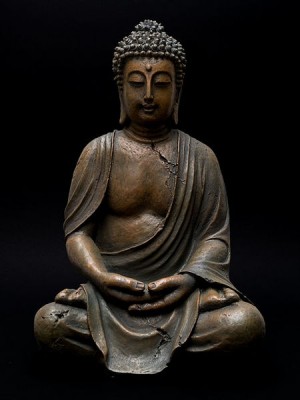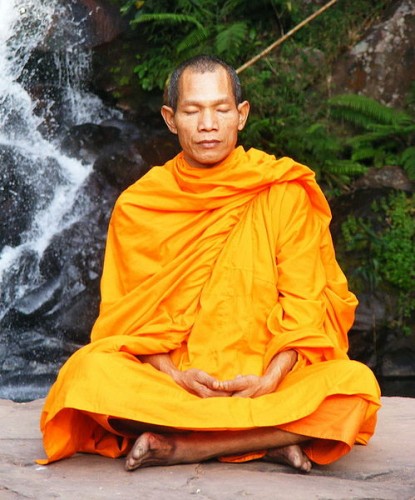We sit staring across from each other. He wears loose shorts and a tank-top. I note his tattoos. There is one of a twisting rose upon his forearm, and a few more upon his legs—of what, I can’t make out. His eyes are pale blue. As I stare into them I note the slight dilation of his pupils. We continue to gaze at one another, my mind racing. What to think? What to do? I know my knee wants to jiggle. Calm, calm. I repeat, You and this man are columns of energy, nothing more, nothing less.
Released by a chime. My partner and I let out sighs, my soliders relax a bit and we both laugh; we’re allowed to look away from each other now.

We sit in a large, windowless shrine room at the Shambhala Meditation Center in Brookline Massachussets. It’s a short T-ride from BU: three stops along the D line, from Kenmore square. The center hosts an under-thirties meditation night every Tuesday. College students and professionals from the Brookline and Boston area come to mingle and meditate.
Which is how I found myself cross-legged on a cushion, in uninterrupted eye contact with a perfect stranger, ruminating on verbal and non-verbal communication, as an odd kinship formed between us.
Shambhala divides its Tuesday into three sections. Silent meditation is the first. Meditators—tonight there are twenty-four—sit cross-legged on blue cushions, in silence, eyes downcast or closed, palms open.
After a half hour of sitting, we segue into a social meditation. Members move their cushions into a wide circle. We sit together surrounded by decorative tapestries and cream walls. Shambhala has a weekly theme to discuss. Today the theme, loosely followed, is gratitude.
Rather like a Quaker service, meditators sit quietly, raising their hands to speak when they are inspired to share with the group.
“Gratitude is the theme tonight, right?” says a girl with unruly brown curls. The instructor nods. “I keep a gratitude journal,” she says. “It started as a psych project but now it’s a habit. It keeps me just a little bit happier when my life is a mess.”
“I keep a record of these things too,” says one man. “Not only things that I’m grateful for but things that I’ve done well. I find my faults easier to remember and when I make momentary decisions having a more fair view of myself helps me make kinder choices.” People nod and hum in sympathy.
“I can tell when I’m practicing fake or real gratitude,” Ssys another participant, “Sometimes it’s really just easier to cry. When I get to rock bottom, I end up finding gratitude. It’s weird, I know.”
“That’s very interesting,” the instructor nods. “What does it feel like in your body? How can you tell when you’re feeling real or fake gratitude?”
The instructor often asks, “How does it feel in your body?” Shambhala is a type of mindfulness mediation, based upon the idea that there is a strong connection between the mind and the body. Tuning into this connection through meditation and study is, according to the Shambhala website, believed to “open the door to the compassionate care of ourselves and others.” In addition to greater compassion, mindfulness meditation has noted health benefits. These include stress reduction, an increase in gray brain matter, and a bolstering of the immune system.
For the second part of social meditation we partner off and stare into each other’s eyes for extended periods of time. For the most part weren’t not allowed to talk, but the instructor does let us say ten words to our partner after the second round.
The partner meditation ends with a brief reflection on the experience. Then we are encouraged to bring our more open attitude into every day life, as we walk quietly from the upstairs shrine room down to the first floor of the center.
The first floor is comprised of a lounge and kitchen with a little back section for administrative offices. There is also a library, free cookies and tea, and lots of couches. Tonight, as luck would have it, someone decided to order pizza.
People laugh by the pizza and strike up conversation with strangers. I meet Sawyer and Wilder, two students from Emerson College. It’s their first night here as well. We talk about hummus. Wilder explains to me a new recipe: cilantro, lime and roasted jalapeño peppers, served with naan. (I mention this mostly because it sounds delicious.)

Shambhala strives to create an “enlightened society” by cultivating the innate kindness within humans.
The result is a rather alien environment: open to the point of odd, friendly to the point of indiscriminate, creating a social norm of blind acceptance—can one call it love?
Amidst the general hustle and bustle of the 21st century and the stress of midterms, the environment feels as cozy as the cup of tea in my hands.
If you’ve practiced meditation and want to learn more; if the idea of Om is foreign and you want to stretch yourself; if life is a constant source of AHHHHH; if you simply want to meet some nice, loving people and gain a new routine for Tuesday nights, visit Shambhala.
No matter what happens you will learn something. Perhaps it will be simple like a new recipe for hummus. Perhaps it might even be profound.
Shambhala hosts under thirty meditation nights every Tuesday. from 7p.m-9p.m. Click here to find out more or visit the Shambhala Meditation Center of Boston: 646 Brookline Avenue, Brookline, MA 02445. If you don’t want to meditate but would like a small dash of “omm” in your day, this blog has you covered.





2 Comments on “Shambhala Meditation Center: An Oasis of Calm and a Midterm Antidote”